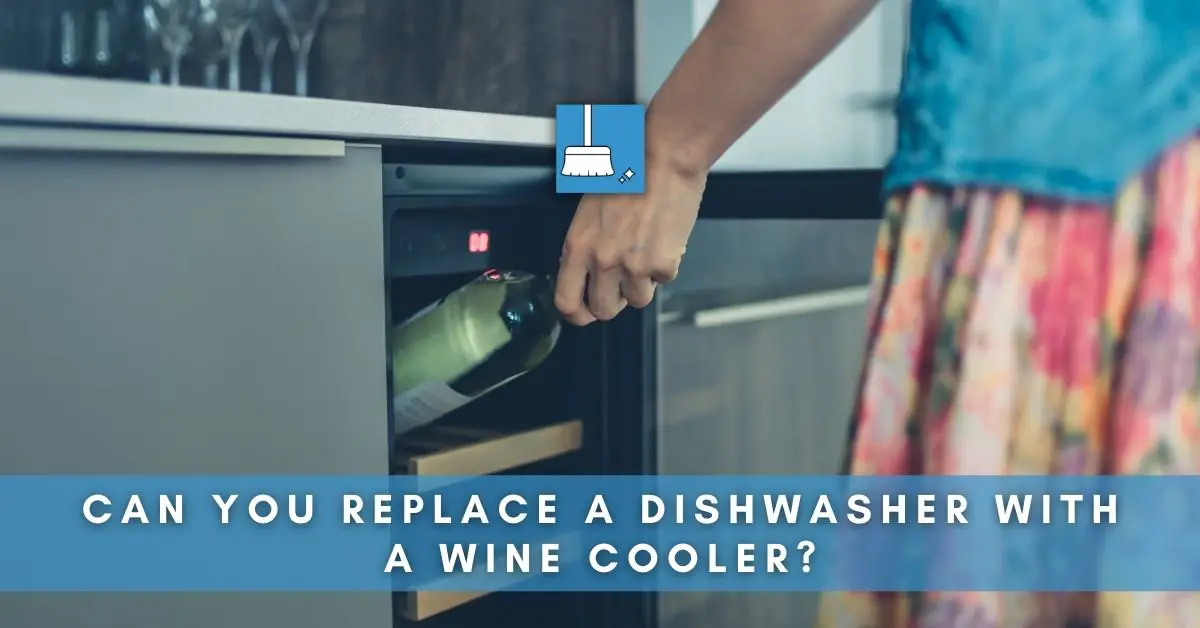Replacing an old, non-functional dishwasher that is occupying space with other usable appliances such as wine cooler is a great way of using that held-up space. Nevertheless, it requires proper planning.
In this article, we’ll be walking you through every single detail you need to know about replacing a dishwasher with a wine cooler- ranging from electrical advice, plumbing tips, and wine cooler comparisons, just to mention a few.
Replacing Dishwasher With Wine Cooler!
Are you already making plans to move a wine cooler or mini refrigerator (as you might choose to call it) into the kitchen space that is currently or was previously occupied by the dishwasher?
Can You Replace Your Dishwasher With A Wine Cooler?
Whether it is a built-in dishwasher or a freestanding dishwasher that occupies that cabinet space, it can be replaced with a wine cooler. You only need to consider space, plumbing, and power requirements.
What to Consider before Replacing a Dishwasher with a Wine Cooler?
It is good to bear in mind that making installation plans in the home requires careful planning in order for you to have oversight over every step and not be caught off guard about anything.
Here’s what you should know before replacing your dishwasher with a wine cooler.
1- Space
How much available space do you have at your disposal? That is one of the most pertinent questions to ponder upon.
Before you purchase a wine cooler, do well to have the space measured up in both height and width. The figures you have at your disposal would determine which size and type of wine cooler you will be getting.
2- Pipes & Garbage Disposal
A lot of dishwashers function with garbage disposal and are located next to the sink.
If a wine cooler is going to be taking that exact space, you must be careful about removing the garbage disposal in order to avoid a spill or preferably, call a plumber to do that for you.
Not only that, you must be careful about the sink pipes when you or an expert is having the wine cooler. You do not want any pressure to be exerted on the pipes.
3- Power Outlet
As we all know, wine coolers are powered by electricity; while preparing to have the wine cooler placed under the counter, also make plans to have a power outlet installed on the wall behind the wine cooler or somewhere safe and close by.
Installing a power outlet should be done when the dishwasher that was previously in that space was a portable dishwasher.
You also should be careful not to have the power outlet installed close to the pipes to avoid any electrical spark, peradventure a spill happens someday.
Can I Replace a Dishwasher with a Wine Cooler by Myself?
This installation can be done by anyone.
However, to replace a dishwasher with a wine cooler all by yourself requires having plumbing knowledge, (especially when you have to get the dishwasher out first), experience in handling electrical fittings (if there’s a need to fix an outlet), and probably carpentry (just in case you need to create extra space above, below or by the sides).
If you can’t check these boxes 100%, it is best to leave the work for an expert to handle.
Built-in vs Freestanding Wine Cooler
| Built-in Wine Cooler | Freestanding Wine Cooler | |
| Space | They are designed to function only when integrated inside a cabinet space. | They are designed to function within any space, whether while fixed under a counter or when set up in an open area. |
| Zone Unit | Due to the size of most Built-in Wine Coolers (small to medium), they are designed to only accommodate a single temperature unit or at most, dual. This means that there can only be one or two temperature settings within the wine cooler, which will maintain each wine according to its service temperature. | Freestanding Wine Coolers are produced in varieties of zone units and are not limited like the Built-in Wine Coolers. In the market today, there are different brands of Freestanding Wine Coolers, ranging from single-zone units, dual-zone units, or multiple zone units. Depending on whatever suits you and your budget, you have the freedom to select which temperature settings you would love to maintain your wines and even beverages. |
| Size | Kitchen cabinet space varies in size, but more often than not, they can only accommodate medium to small-sized appliances. In essence, Built-in Wine Coolers are seldom found in large sizes, just within the medium to the small-sized range. This places a limit on how many wines and beverages they can accommodate. | Freestanding Wine Coolers are available in various dimensions and capacities. There are small to large-sized Freestanding Wine Coolers available in the market, today. So, irrespective of how many wine and beverages you choose to have stored in your wine cooler, Freestanding Wine Coolers will always have your back on it. |
| Vent Placement | Built-in Wine Coolers have their vents located at the front of the appliance. It is designed this way for the free dissipation of heat out of the appliance and cabinet space in which it would be stored. | Freestanding Wine Coolers have their vents designed at their rear and sides. This is because the manufacturer intends them to be placed in an open space, whereby the heat is emitted into the open space. |
Does A Wine Cooler Need Its Own Circuit?
You can have your wine cooler attached to the current electric circuit you use at home and it could need its own exclusive circuit. However, having another electrical appliance in the house requires insight into how well the current circuit can handle its voltage.
To discover if your wine cooler needs its own circuit or not, here are 2 factors to consider:
1- The Voltage of the Wine Cooler
It all boils down to the size of your Wine Cooler, the amount of electrical energy (volts) that your Wine Cooler carries, and if the circuit in your home can carry that amount of weight.
Usually, a small-sized wine cooler does not carry so much voltage and can share an existing electrical circuit in the house without weighing on it too much.
While a large-sized one would carry a lot of electrical energy and might impact the circuit when plugged into it. In the case of the latter, it is best to have a separate circuit created for your wine cooler.
2- Total Electrical Appliances That Are Connected to the Circuit
If the current circuit used in the house already has a number of appliances with heavy voltage attached to it, then it is wise to let the wine cooler have its own circuit. By doing so, your wine cooler would function without any electrical current glitches.
Note: In every electrical-related decision that you take as regards the installation, it is advisable to seek the services of a pro electrician before taking any step.
In the case where you already have a separate circuit created or the circuit being used in the house can accommodate the wine cooler, ensure that the appliance is not plugged into an extension box, rather connect it directly to the main power outlet.
Is a Wine Cooler the Same Size as a Dishwasher?
A wine cooler can be of the same size as a dishwasher.
Often, wine coolers are produced in the exact measurement as that of a dishwasher. This is because manufacturers of wine coolers, based on customer analysis, are beginning to discover that customers frequently replace dishwashers with wine coolers and are now creating them (especially, the built-in) to be able to fit into the standard dishwasher size cabinets.
Electricity Consumption
How Much Electricity Does A Wine Cooler Use?
The voltage capacity of the wine cooler depends on the amount of electricity it would draw. A wine cooler draws between 70 to 200 watts. A small-sized wine cooler that holds a maximum of 30 bottles will most likely use between 70 to 90 watts, while the larger wine coolers would use about 200 watts of electricity.
How Much Electricity Does A Dishwasher Use?
Dishwashers carry a lot of electrical energy. The lowest electrical power it runs on is about 1200 watts and the highest is about 2400 watts. The average dishwasher tends to operate on about 1800 watts.
The amount of electricity a dishwasher uses is hinged on the capacity and size of the appliance.
How To Replace A Dishwasher With A Wine Cooler?
STEP 1: Have a plumber and carpenter carefully disconnect the dishwasher’s pipes, garbage disposal, air gap, and the dishwasher itself from the cabinet space.
STEP 2: Measure the cabinet space and the wine cooler. If there’s a need to make extra space, do well to saw the wood off by the sides, top, or bottom of the cabinet so that the wine cooler would fit in perfectly.
STEP 3: Sweep the cabinet space.
STEP 4: Follow the manual for easy setup.
STEP 5: Place the wine cooler within the cabinet space carefully.
STEP 6: Wait for about 5 to 10 minutes before plugging the wine cooler.
Where Else Can You Put A Freestanding Wine Cooler?
Office
Whether you work remotely or on-site, you can have a freestanding wine cooler placed in a corner of your office, where you can always have a few drinks alone, with friends, colleagues, or clients to ease yourself off of stress or discuss a project, and maybe, close a deal.
Bedroom
You can place a freestanding wine cooler in your bedroom, a small-sized one preferably. You can always and easily reach out for a drink at any time of the day while relaxing in your room alone or with a loved one.
Final Thoughts!
It is always a wise idea to make constructive use of unutilized spaces in the house. People often try to use such spaces for installing an oven or a washing machine. It’s amazing having a wine cooler in the house. Replacing a dishwasher with a wine cooler is such a great idea and a useful way to utilize space.
In this article, we have walked through all the vital information you need to be equipped with before taking this big decision.






Pingback: Can You Install A Washer Instead Of Dishwasher? (DIY Guide!) »
Pingback: Can You Replace A Dishwasher With An Oven? (How?) »